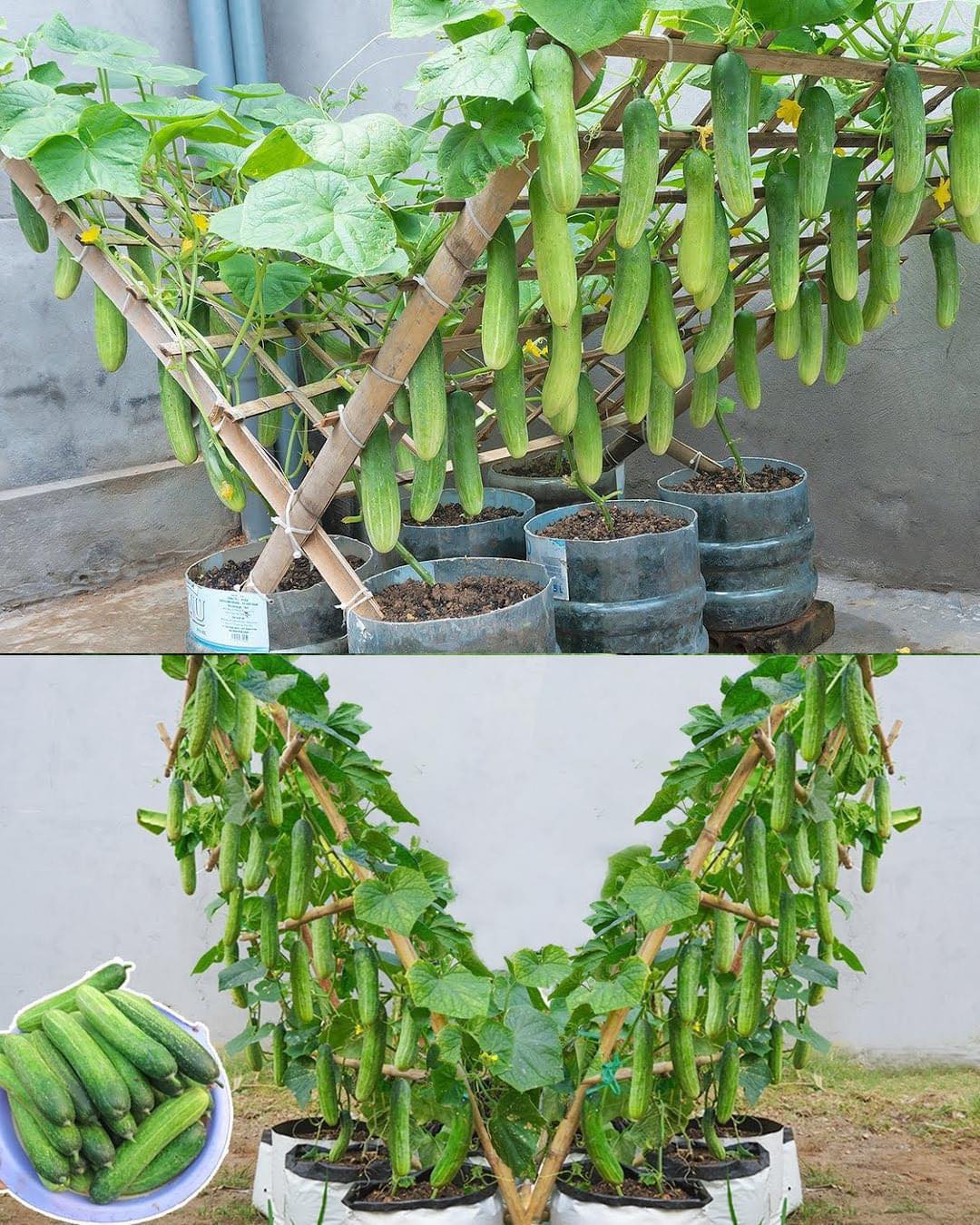
Vertical gardening is a great way to save space in your backyard and make it easier for you harvest.
Grow cucumbers vertically to maximize the amount of space you have in your garden and make harvesting easier. Growers can savor succulent cucumbers, even in small spaces, with a bit of pre-planning and experience.
Start by choosing the right variety for vertical growth – this will ensure that you get good results. Then prepare the growing area properly with ample sunlight and well-draining soil.
Planting is key as proper training techniques are necessary for successful vertical growth; water frequently but do not over saturate your plants, fertilize regularly according to instructions on packages or labels.
Finally learn when it’s time to harvest those juicy fruits – they should be picked while still young so they remain tender and full of flavor. Grow cucumbers vertically today and reap all these amazing benefits
Choosing the Right Variety of Cucumber
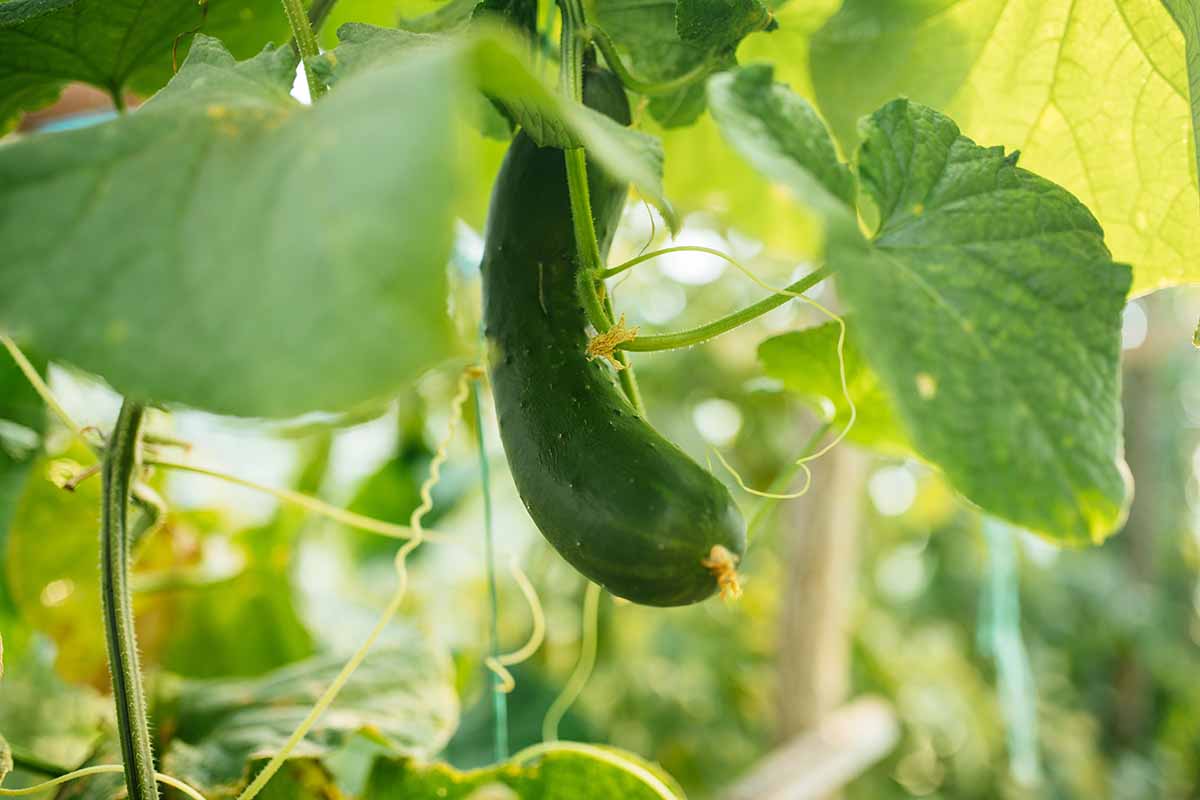
When it comes to growing cucumbers vertically, there are certain varieties that work best. Bush and vining types of cucumber plants are the most suitable for vertical gardening because they produce long vines with many fruits.
These types of cucumbers can be perfect for limited areas, such as small gardens or containers, due to their requirement for less space than other varieties.
When choosing a variety of cucumber for vertical gardening, look for ones that have been bred specifically for this purpose. Some examples include ‘Bushy Baby’, ‘Tasty Green’, and ‘Spacemaster’.
These varieties tend to be more compact in size and will not take up too much room when grown vertically. They also tend to produce larger yields than other types of cucumbers due to their ability to climb higher up the trellis or support structure.
Another important factor when selecting a variety is disease resistance.
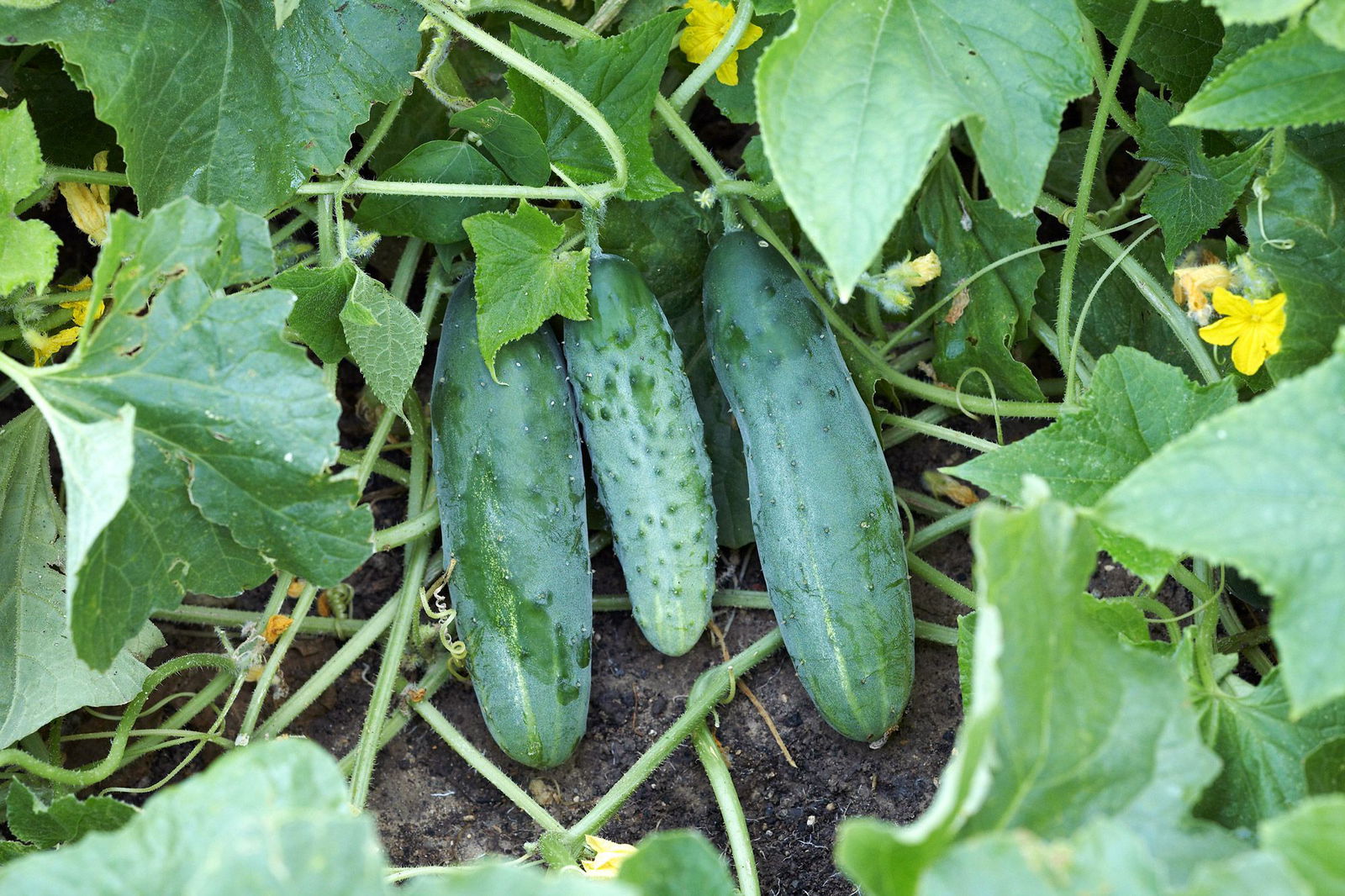
Cucumber plants can be susceptible to various diseases such as powdery mildew and bacterial wilt, so it’s important to choose one that has good resistance against these problems.
Look for varieties labeled “disease resistant” on the seed packet or catalog description if possible.
When selecting a variety, also consider how you plan to use your harvest. If pickling is your goal, look for varieties such as ‘Boston Pickling’ or ‘County Fair’.
For slicing cucumbers, try something like ‘Marketmore 76’ or ‘Straight Eight’, and if you’re looking for tasty snacks then go with something like ‘Lemon’ or ‘Suyo Long’.
Ensure that the cucumber variety you opt for harmonizes with your garden’s overall layout prior to planting it.
When it comes to growing cucumbers vertically, the right variety is key – so make sure you pick one that suits your needs and space.
Now that you’ve chosen the perfect variety, let’s look at preparing a suitable growing space for your vertical cucumber garden.
Key Takeaway: Key takeaway: Choose cucumber varieties that are bred for vertical gardening, have good disease resistance, and fit into your garden’s overall design to maximize yields.
Preparing the Growing Space

Preparing the Growing Space for Cucumbers is an important step in ensuring a successful harvest. The right container and trellis are essential to maximize your yield.
When deciding on a pot, pick one that is sufficiently big to hold the quantity of cucumber plants you intend to cultivate.
A 20-gallon pot should be sufficient for two or three plants, while larger containers may be needed if more plants are desired. Make sure the pot has plenty of drainage holes at the bottom so excess water can escape easily.
The trellis type selected is contingent on the amount of available area and the required support for your cucumber plants as they develop.
If you’re limited on space, opt for a wall-mounted vertical trellis system that allows vines to climb up from the ground level without taking up too much room in your garden bed or patio area.

Alternatively, if you have more room to work with, consider using a traditional horizontal trellis setup where vines can spread out along wires or strings attached between posts set into the ground at either end of your planting area.
Once you have selected a suitable container and trellis system, it is time to fill it with soil mix specifically designed for vegetables such as cucumbers.
This soil mix, tailored for veggie growth, will supply the plants with all their essential nutrients during their lifecycle. Ensure the soil mix has enough drainage by adding some pebbles or sand before filling up your potting tray with the mixture until it reaches a few inches below its rim.
Doing this will help guarantee proper aeration and prevent root rot caused by standing water around roots due to poor drainage conditions inside pots/containers during rainy seasons when watering needs are higher than usual compared to dryer periods where less frequent irrigation cycles suffice instead.
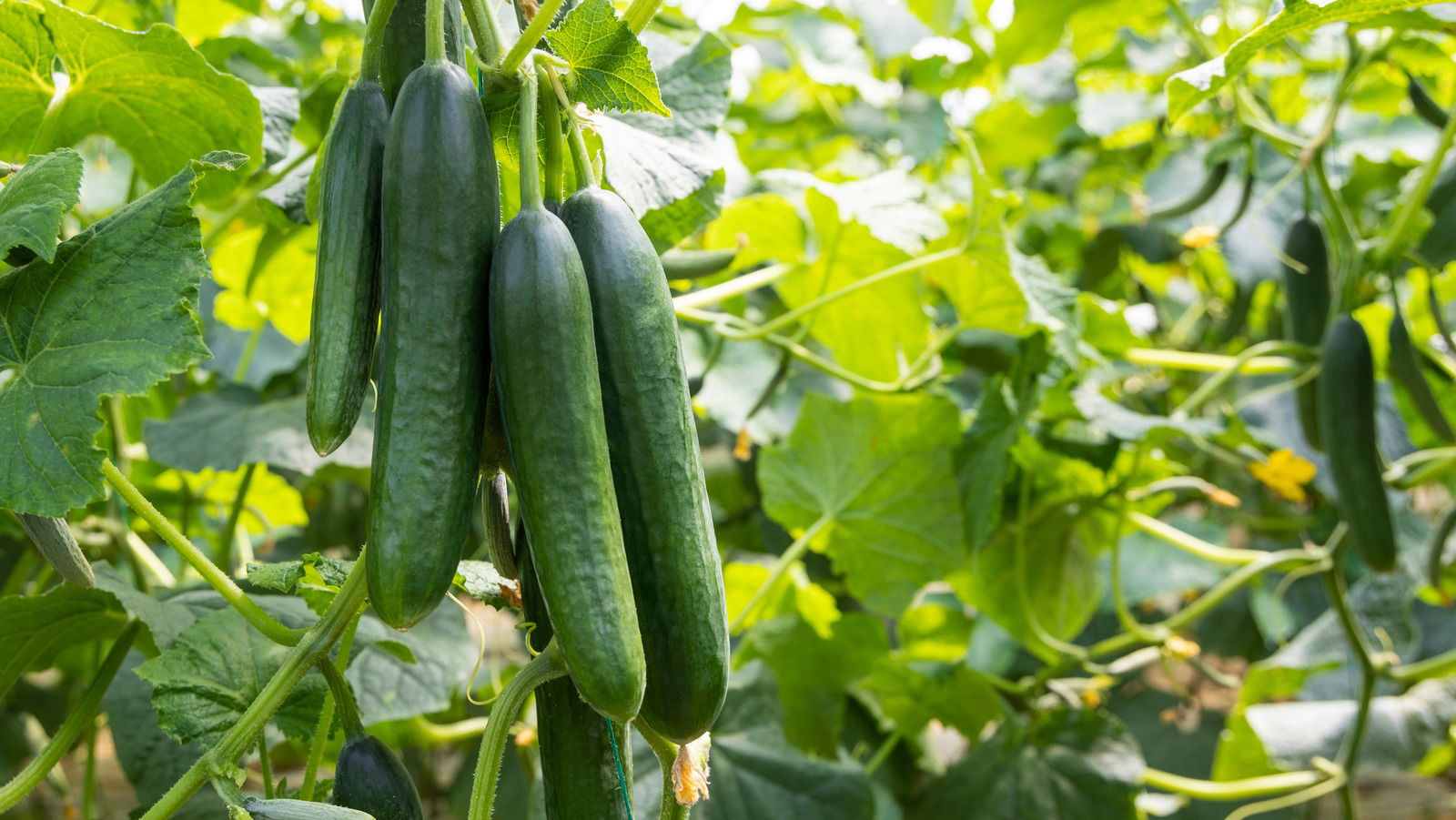
Finally, place your selected variety’s seeds into pre-made furrows (or drill small holes) spaced 8–10 inches apart within each row depending upon specific instructions found on seed packets.
Cover lightly with additional soil mixture before gently pressing down firmly over top surface layer using hands so as not to damage delicate seedlings which could otherwise occur from applying excessive pressure during initial stages after sowing process has been completed successfully.
Once the growing space is prepared, it’s time to move on to planting and training cucumbers – a task that requires careful attention and guidance.
Key takeaway: Plant cucumbers in a large container with adequate drainage, use a trellis system to support the vines, and fill with soil mix designed for vegetables before sowing seeds 8-10 inches apart.
Planting and Training Cucumbers
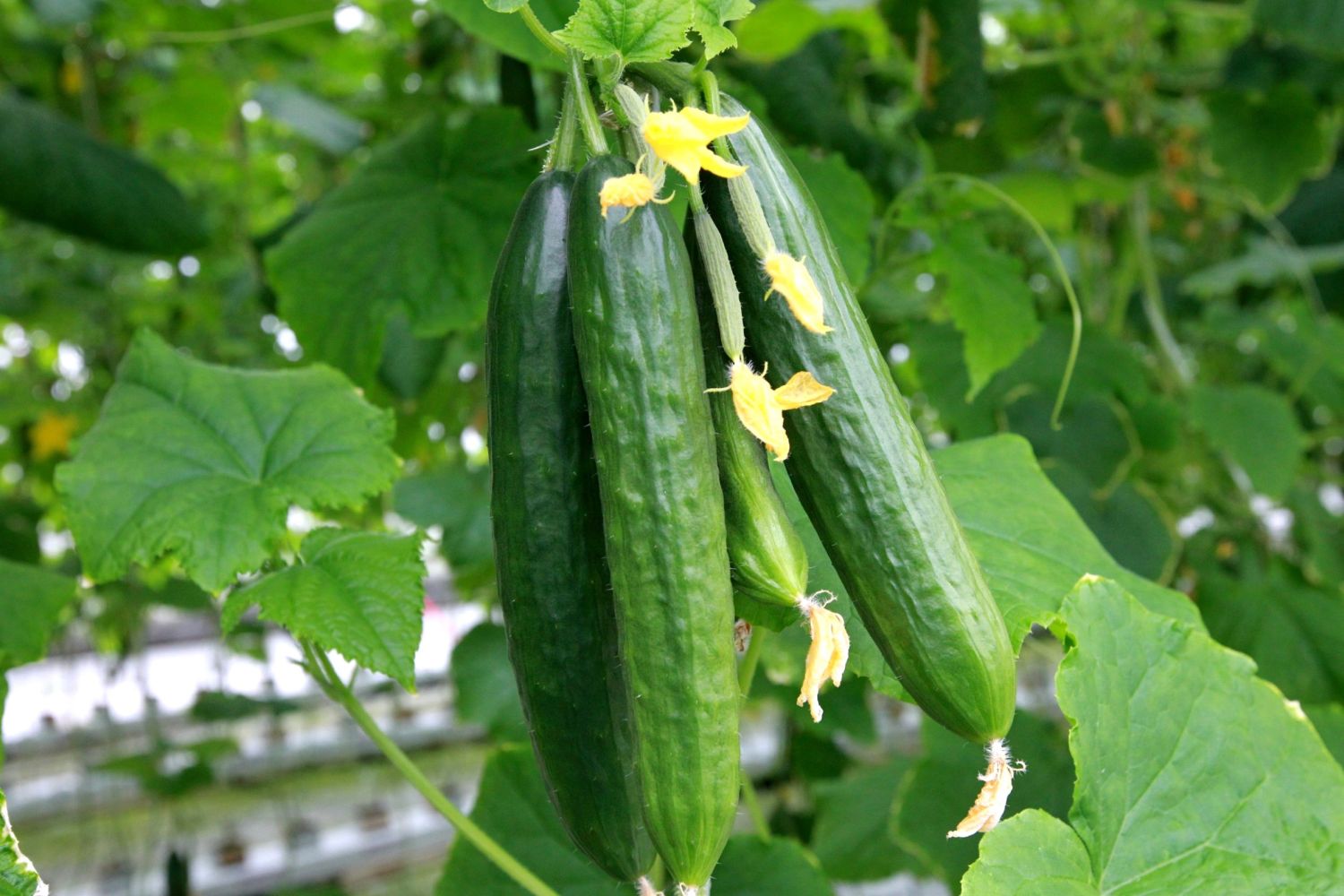
Planting cucumbers should be done when the soil temperature has reached 60°F, typically in late spring or early summer. Before planting, mix in a generous amount of compost and fertilizer into the soil.
Ensure that your cucumber seeds are embedded one inch deep, and spaced 3-4 inches away from each other in rows which should be 4-6 feet apart. Water thoroughly after planting and keep the soil moist until germination occurs (usually within 5-7 days).
Training Cucumbers:
Training cucumbers vertically is an effective way to maximize space in small gardens. The most common support structures for training cucumbers are trellises, fences, stakes, or cages.
When tying up your plants on these supports make sure not to tie them too tightly as this can cause damage to their stems over time.
It’s also important to note that if you plan on harvesting large fruits from your vines it’s best practice to provide extra support with string or netting underneath each fruit so they don’t break off due to their weight once ripe.
Harvesting cucumbers should begin when fruits reach about 6 inches long and have turned a dark green color, usually around 2 months after planting depending on variety grown and weather conditions during growth period.
To harvest, simply cut the stem just above where the fruit attaches using sharp scissors or knife, being careful not to remove any foliage while doing so as this will encourage more production throughout the season.
By staking and training your cucumbers to grow vertically, you can ensure that they will get the most sunlight and space possible. Now let’s look at how we can keep them healthy with proper watering and fertilizing.
Watering and Fertilizing
Watering and fertilizing are essential for healthy cucumber growth and maximum yields. Cucumbers require a lot of water to thrive, so it’s important to keep the soil moist but not soggy.
Water your cucumbers at least once or twice a week, depending on the weather conditions. For areas with hotter summers, extra hydration might be needed. In addition to regular watering, fertilizing is also necessary for optimum cucumber growth.
Organic fertilizer is best for cucumbers grown vertically as it helps promote strong root development and vigorous foliage growth.
Apply an organic fertilizer every fourteen days when the temperature is over 65°F (18°C) during the cucumber’s growing season. Avoid using too much nitrogen-rich fertilizer as this can lead to excessive leafy growth at the expense of fruit production.
For container-grown plants, use liquid seaweed extract or fish emulsion diluted in water according to package instructions before planting and then again every two weeks throughout the growing season until harvest time arrives.
For garden beds that have been amended with compost prior to planting, side dressings of compost tea can be applied every few weeks instead of traditional fertilizers if desired.
Properly watering and fertilizing your cucumbers is essential for their growth, so be sure to follow the recommended guidelines. Harvesting cucumbers is the next step in their cultivation – now that you have an understanding of how to care for them, it’s time to begin collecting your crop.
Key Takeaway: Grow cucumbers vertically for maximum yields, and use organic fertilizer every two weeks to promote strong root development and vigorous foliage growth.
Harvesting Cucumbers
Harvesting cucumbers from a vertical garden is an exciting time for any gardener. The fruits of your labor are finally ready to be enjoyed. When harvesting cucumbers, it’s important to do so carefully and gently in order to avoid damaging the plants or fruits.
To determine when cucumbers are ready to be picked, examine their size and hue. Cucumbers should be firm, bright green, and about 6-8 inches long before they’re harvested.
If left for too long, the cucumber can become overly mature and acquire a sharp taste. To pick a ripe cucumber, grasp it firmly with one hand while supporting the vine with your other hand.
Gently twist the fruit off of the vine without pulling on it too hard as this can damage both the plant and fruit.
Post-harvest, it is imperative to examine your cucumbers for any indications of illness or parasites like aphids and mildew prior to ingestion.
Subsequent to gathering your ready cucumbers, it is essential to douse the plants regularly so as to maintain their wellness and stimulate further development.
FAQs in Relation to How to Grow Cucumbers Vertically
How do you train cucumbers to grow vertically?
Cucumbers can be trained to grow vertically by using a trellis or stake. Start by inserting the stake into the ground next to your cucumber plant and then tying the stem of the plant loosely around it with twine or string.
As your cucumber grows, continue to tie it up onto the stake, making sure not to pull too tightly as this could damage the stem.
When you reach the top of your stake, gently wrap some more twine around both sides of each branch so that they are supported in an upright position.
With regular maintenance and care, you should have vertical cucumbers in no time.
How much space do cucumbers need to grow vertically?
Cucumbers need plenty of space to grow vertically. Planting should be done with a gap of at least 18-24 inches between each cucumber, and the rows must have an interval of 3-4 feet.
This will give them enough room to spread out and reach their full potential height. The soil should also be well drained and amended with compost or fertilizer for best results. With proper care, cucumbers can reach heights of up to 8 feet.
Is it better to grow cucumbers on a trellis or on the ground?
It depends on the variety of cucumber and the space available. Generally, trellising is recommended for vining varieties as it allows them to spread out and produce more fruit.
Trellising also helps keep fruits off the ground, reducing risk of rot or disease. However, if you have limited space or are growing bush varieties, planting directly in the ground may be a better option as these plants don’t need extra support from a trellis.
Ultimately, it’s a matter of individual choice and what works best for your particular garden situation.
Should I grow my cucumbers vertically?
Yes, growing cucumbers vertically can be beneficial. It helps to save space in the garden and makes harvesting easier. Additionally, it reduces the risk of disease by allowing air circulation around the plant and encourages more even ripening of fruits.
Vertical cucumber trellises also help protect fruits from ground-dwelling pests like slugs and snails.
Finally, vertical growth can make it easier to spot any potential problems with your plants early on, such as yellowing leaves or stunted growth. All in all, growing cucumbers vertically is a great way to maximize your garden’s potential.
Conclusion
Maximizing garden space and obtaining an abundant yield can be achieved by growing cucumbers vertically.
With the right variety, proper preparation, planting and training techniques, regular watering and fertilizing schedule, you can successfully grow cucumbers vertically in an effective way. So why not give it a try? You may find it surprisingly effortless!
Are you looking for a way to maximize your garden space? Growing cucumbers vertically is an excellent solution. Not only does it provide more room in the garden, but it also allows the cucumbers to get plenty of sun and air circulation while they are growing.
With just a few simple steps, you can learn how to grow these delicious vegetables up instead of out!



















